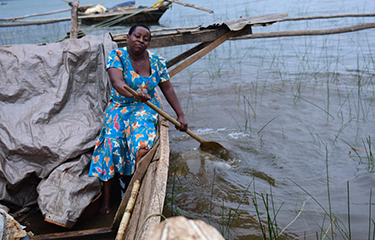Persistent illegal fishing is hampering the growth of Rwanda’s landlocked fishing industry, which currently produces an estimated 26,730 tons of fish – far below an earlier-envisaged national goal of 112,000 tons, which would have met an increasing demand from expanding rural and urban populations by 2020.
Rwanda, which has an estimated population of 12.6 million people, currently relies on Tanzania and Uganda for fish imports, some of which it then re-exports to neighboring Democratic Republic of Congo.
Participants at a fishing industry forum in late January said illegal fishing is rampant in Rwanda’s water bodies, and has been made worse by the lack of a central fisheries management agency to regulate and enforce compliance in the country’s fishing industry, which is largely artisanal and operated by small-scale fishers, according to The New Times.
"This fish poaching, practiced by both non-members and members of cooperatives, is also linked to dealers who sell illegal nets and low-quality fishing materials, and it is hurting this industry. We must stop them," Cecile Uwizeyimana, an official in charge of aquaculture at the Rwanda Agricultural Board, said.
Across many of the 24 lakes in Rwanda where small scale fishing is practiced, participants attributed the increased illegal fishing to multiple factors: The involvement of officials from local fishing cooperatives, the country’s unstructured fish market, and inadequate mechanisms to enforce global fishing industry standards.
The challenges facing Rwanda’s fishing industry have largely contributed to the low fish consumption per capita of 2.3-kilograms per person annually, far below the average 6.7 kilograms of the rest of sub-Saharan Africa, and the 16.6 kilograms globally.
In addition, the low returns from the country's predominantly small-scale fish farming sector has constrained production of Rwanda’s fisheries resource to a mere 10 percent of its national potential, according to the Ministry of Agriculture and Animal Resources’ 2011-2020 Master Plan for Fisheries and Fish Farming.
“The only plausible cause for depletion of native stocks remains excessive fishing capacity and use of destructive gears in all the water bodies,” the plan said.
Illegal fishing has also contributed to the low returns, as fish stocks are impacted by overfishing, according to the ministry.
“As a result of illegal, unregulated, and unreported fishing over a long period, the natural fish stocks have been depleted and fish stocks in most lakes have collapsed to the extent that our recent assessment of catch after 12 hours of fishing was only 2 kilograms of fish per boat,” the plan adds.
However, the Rwanda Agriculture and Animal Resources Development Board, a state agency for the promotion of the development of the agricultural sector, is optimistic that leveraging the expanding middle class and urbanization levels in the country would catalyze fish production in the medium- and long-term.
Furthermore, the government has proposed embracing a concessionaire fishing model in place of the current open access and common resource principle. However, that model has so far been held back because of a lack of necessary legislation.
Photo courtesy of the FAO







